Strategic Marketing Plan Analysis and Recommendations for Primark
VerifiedAdded on 2020/01/21
|12
|3103
|42
Report
AI Summary
This report provides a detailed analysis of Primark's marketing plan, focusing on various aspects such as marketing planning, internal and external environment analysis, and the application of marketing strategies. The report includes an examination of Primark's strengths, weaknesses, opportunities, and threats (SWOT analysis) and Porter's five forces analysis to assess the external environment. It also delves into the introduction of a new product (twin kids apparel) in the Dubai market, outlining the marketing activities, budgeting, and implementation strategies. The report further discusses the importance of marketing planning in achieving corporate objectives, the application of different marketing strategies (creation, innovation, improvement, and enhancement), pricing, distribution, and communication policies. It concludes by addressing potential issues and ethical considerations that Primark may encounter during the implementation of its marketing plan. This report serves as a comprehensive guide to understanding Primark's marketing approach and its implications.

Marketing Planning
Paraphrase This Document
Need a fresh take? Get an instant paraphrase of this document with our AI Paraphraser
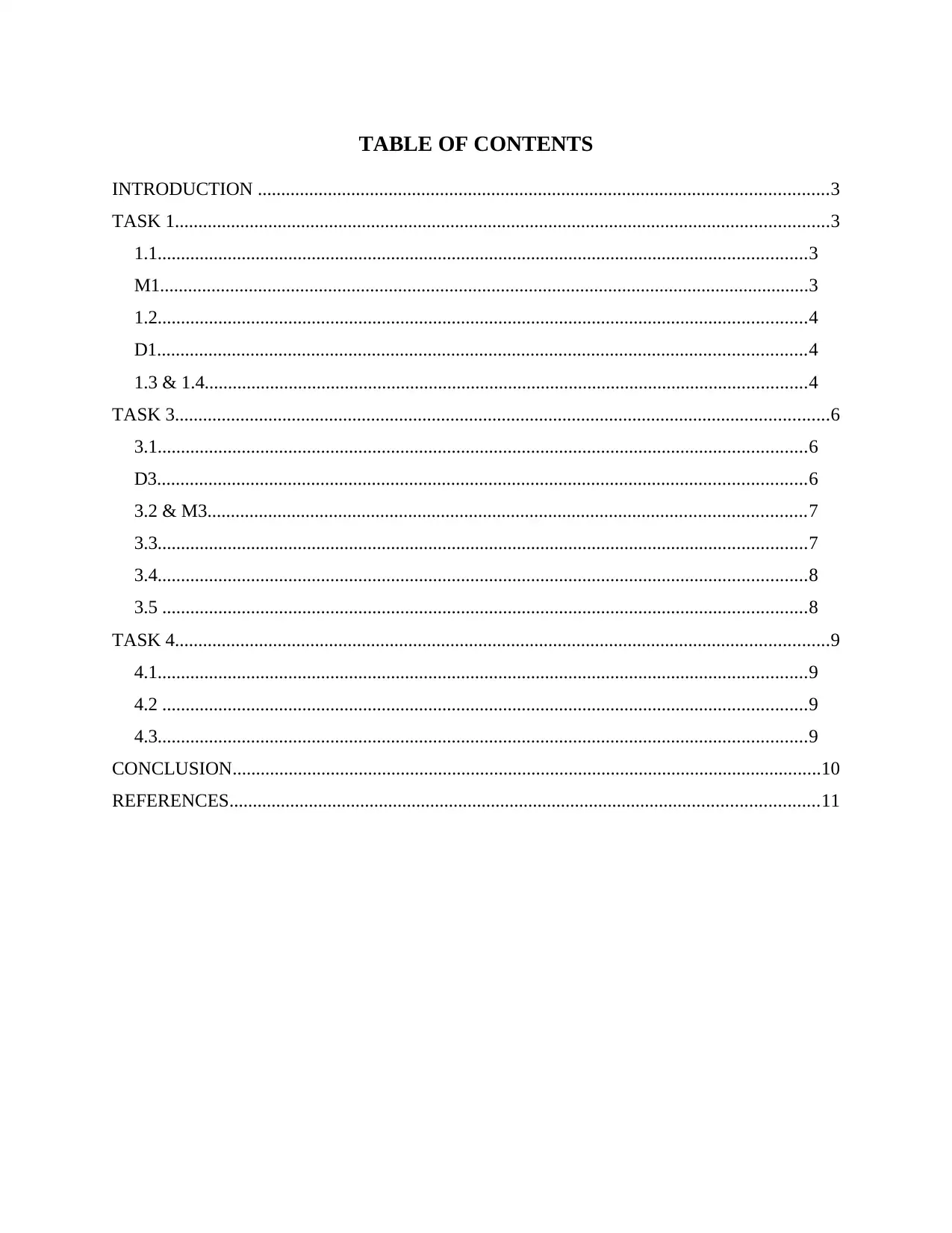
TABLE OF CONTENTS
INTRODUCTION ..........................................................................................................................3
TASK 1............................................................................................................................................3
1.1...........................................................................................................................................3
M1...........................................................................................................................................3
1.2...........................................................................................................................................4
D1...........................................................................................................................................4
1.3 & 1.4.................................................................................................................................4
TASK 3............................................................................................................................................6
3.1...........................................................................................................................................6
D3...........................................................................................................................................6
3.2 & M3................................................................................................................................7
3.3...........................................................................................................................................7
3.4...........................................................................................................................................8
3.5 ..........................................................................................................................................8
TASK 4............................................................................................................................................9
4.1...........................................................................................................................................9
4.2 ..........................................................................................................................................9
4.3...........................................................................................................................................9
CONCLUSION..............................................................................................................................10
REFERENCES..............................................................................................................................11
INTRODUCTION ..........................................................................................................................3
TASK 1............................................................................................................................................3
1.1...........................................................................................................................................3
M1...........................................................................................................................................3
1.2...........................................................................................................................................4
D1...........................................................................................................................................4
1.3 & 1.4.................................................................................................................................4
TASK 3............................................................................................................................................6
3.1...........................................................................................................................................6
D3...........................................................................................................................................6
3.2 & M3................................................................................................................................7
3.3...........................................................................................................................................7
3.4...........................................................................................................................................8
3.5 ..........................................................................................................................................8
TASK 4............................................................................................................................................9
4.1...........................................................................................................................................9
4.2 ..........................................................................................................................................9
4.3...........................................................................................................................................9
CONCLUSION..............................................................................................................................10
REFERENCES..............................................................................................................................11

INTRODUCTION
Marketing plan can be stated as one of the most crucial part of business because it
directly assists firm to communicate the nature of intended business in regard to attain success
(Bowie, 2010). Here, different concepts of marketing has been analyzed in order to practically
implement it in relation to Primark. It is very popular retail clothing store that provides clothes to
customers at reasonable and affordable prices. Further, different tasks need to be accomplished
in relation to Primark.
TASK 1
1.1
Primark's marketing department is required to develop continuous review of changing
perspectives in the marketing planning context so that large number of audiences can be attracted
which helps in improving the sales of business. It focuses upon traditional marketing planning
methods so that they can provide a wide range of retail products to consumers. However, it is
significant for business to regularly review the changing perspectives in marketing planning as it
helps Primark's management to make effective decision in regard to attain results (Bryson,
2011). Thus, through reviewing such perspectives it helps firm to reformulate its marketing plan
which assists them to make efforts in regard to enter into potential market and attain growth.
While, modern marketing planning focuses upon implementing effective ways in regard to
promote and advertise the products into market and enhance the sales and profitability. It helps in
building good reputation in market and thus attain competitive edge over rivals. However, it is
required for business to review its policies and plans so that they can focus upon future
perspective in regard to grow the business and attain objectives (Foroud and et. al., 2010).
M1
From the auditing, certain inferences are made which states that there is the use of
appropriate conventional marketing methods such as direct selling, promotion through sales and
others it lags behind in adopting modern methods. Using the following two strategies will
provide lucrative results:
Adopting advanced ways of marketing such as digital marketing and having interactions
with marketers and suppliers on virtual platform.
Marketing plan can be stated as one of the most crucial part of business because it
directly assists firm to communicate the nature of intended business in regard to attain success
(Bowie, 2010). Here, different concepts of marketing has been analyzed in order to practically
implement it in relation to Primark. It is very popular retail clothing store that provides clothes to
customers at reasonable and affordable prices. Further, different tasks need to be accomplished
in relation to Primark.
TASK 1
1.1
Primark's marketing department is required to develop continuous review of changing
perspectives in the marketing planning context so that large number of audiences can be attracted
which helps in improving the sales of business. It focuses upon traditional marketing planning
methods so that they can provide a wide range of retail products to consumers. However, it is
significant for business to regularly review the changing perspectives in marketing planning as it
helps Primark's management to make effective decision in regard to attain results (Bryson,
2011). Thus, through reviewing such perspectives it helps firm to reformulate its marketing plan
which assists them to make efforts in regard to enter into potential market and attain growth.
While, modern marketing planning focuses upon implementing effective ways in regard to
promote and advertise the products into market and enhance the sales and profitability. It helps in
building good reputation in market and thus attain competitive edge over rivals. However, it is
required for business to review its policies and plans so that they can focus upon future
perspective in regard to grow the business and attain objectives (Foroud and et. al., 2010).
M1
From the auditing, certain inferences are made which states that there is the use of
appropriate conventional marketing methods such as direct selling, promotion through sales and
others it lags behind in adopting modern methods. Using the following two strategies will
provide lucrative results:
Adopting advanced ways of marketing such as digital marketing and having interactions
with marketers and suppliers on virtual platform.
⊘ This is a preview!⊘
Do you want full access?
Subscribe today to unlock all pages.

Trusted by 1+ million students worldwide

Hiring employees and marketeers with in-depth understanding of current market status
and ways to leverage their benefits.
1.2
Primark management announces a new marketing strategy in regard to reduce the prices
and enhance the sales improvement channels to attain maximum results. Main capabilities of
Primark is to plan its future marketing activity i.e. human, physical and financial in order to
attract large set of customers and thus enhance the sales and profitability in market. In regard to
plan its future marketing activity, Primark aims to develop its human resources by providing
them different training sessions and thus enhance their skills and capabilities so that they can
attract large set of customers (Organizational capability. 2015). Further, by developing physical
abilities such as producing unique products helps in improving the brand image of firm in
market. Company aims to offer products at unique prices so that large number of consumers can
be attracted towards Primark. Also, it is essential for Primark to build its financial capability
through closing the non performing outlets in the countries and thus saving a huge amount which
could be invested in other areas and expand the business in foreign markets to attain set targets
(Gubb, 2010).
D1
The suggested strategies have both advantages and disadvantages, in that regard critical
analysis is done.
Hiring capable marketeers will improve financial capabilities of organization with cost
minimization and profit maximization due to effective marketing but it demands regrous
approach of recruitment which is time consuming in nature.
Use of advance methods of marketing increases physical capabilities but at the same time
it is expensive.
1.3 & 1.4
It involves different techniques which can be identified by Primark management so that
effective organizational audit i.e. internal and external environment can be made that influences
the marketing planning of Primark. It is essential for business to carry out SWOT analysis for
internal and Porter five forces for external analysis (Helman, 2010). Following are the internal
and external analysis which are as follows-
and ways to leverage their benefits.
1.2
Primark management announces a new marketing strategy in regard to reduce the prices
and enhance the sales improvement channels to attain maximum results. Main capabilities of
Primark is to plan its future marketing activity i.e. human, physical and financial in order to
attract large set of customers and thus enhance the sales and profitability in market. In regard to
plan its future marketing activity, Primark aims to develop its human resources by providing
them different training sessions and thus enhance their skills and capabilities so that they can
attract large set of customers (Organizational capability. 2015). Further, by developing physical
abilities such as producing unique products helps in improving the brand image of firm in
market. Company aims to offer products at unique prices so that large number of consumers can
be attracted towards Primark. Also, it is essential for Primark to build its financial capability
through closing the non performing outlets in the countries and thus saving a huge amount which
could be invested in other areas and expand the business in foreign markets to attain set targets
(Gubb, 2010).
D1
The suggested strategies have both advantages and disadvantages, in that regard critical
analysis is done.
Hiring capable marketeers will improve financial capabilities of organization with cost
minimization and profit maximization due to effective marketing but it demands regrous
approach of recruitment which is time consuming in nature.
Use of advance methods of marketing increases physical capabilities but at the same time
it is expensive.
1.3 & 1.4
It involves different techniques which can be identified by Primark management so that
effective organizational audit i.e. internal and external environment can be made that influences
the marketing planning of Primark. It is essential for business to carry out SWOT analysis for
internal and Porter five forces for external analysis (Helman, 2010). Following are the internal
and external analysis which are as follows-
Paraphrase This Document
Need a fresh take? Get an instant paraphrase of this document with our AI Paraphraser

Primark's SWOT analysis
Strengths
Primark owns vast product range and
offer cheap prices to customers.
It involves ethical trading methods and
also take care of workforce (Lucy,
2010).
It is UK's second largest clothing
retailer in regard to volume.
Involves around 20 own brand labels.
Opportunities
Primark possess the opportunities to
expand its operations in European
market.
It works hard to improve the brand
image of company among competitors.
Business can use e-retailing method
(Malphurs, 2013).
Weaknesses
Primark brand name affects due to
allegation of child labor and rights of
workers.
Many times Primark is criticized due to
its quality of clothes (Parsaeifard and
et. al., 2010).
Threats
Primark's competitors make use of
promotion element very well.
Primark competitors Asda's possess its
own brand i.e. George which affects
company's sales (Piercy, 2012).
There are few outlets of Primark which
needs to be closed because of bad
quality of service and unmaintained
products.
Porter five forces analysis
Threat of new entry- It can be state that Primark does not face such issue because it
requires huge investment in regard for people to enter into new market.
Threat of substitutes-It affects the ability of Primark's customers in order to find
different ways of carrying out the business (Geunes and et. al., 2011).
Bargaining power of buyers- It is essential for Primark to lower down its prices so that
they can attract more number of customers because individuals possess different options
to choose from.
Strengths
Primark owns vast product range and
offer cheap prices to customers.
It involves ethical trading methods and
also take care of workforce (Lucy,
2010).
It is UK's second largest clothing
retailer in regard to volume.
Involves around 20 own brand labels.
Opportunities
Primark possess the opportunities to
expand its operations in European
market.
It works hard to improve the brand
image of company among competitors.
Business can use e-retailing method
(Malphurs, 2013).
Weaknesses
Primark brand name affects due to
allegation of child labor and rights of
workers.
Many times Primark is criticized due to
its quality of clothes (Parsaeifard and
et. al., 2010).
Threats
Primark's competitors make use of
promotion element very well.
Primark competitors Asda's possess its
own brand i.e. George which affects
company's sales (Piercy, 2012).
There are few outlets of Primark which
needs to be closed because of bad
quality of service and unmaintained
products.
Porter five forces analysis
Threat of new entry- It can be state that Primark does not face such issue because it
requires huge investment in regard for people to enter into new market.
Threat of substitutes-It affects the ability of Primark's customers in order to find
different ways of carrying out the business (Geunes and et. al., 2011).
Bargaining power of buyers- It is essential for Primark to lower down its prices so that
they can attract more number of customers because individuals possess different options
to choose from.
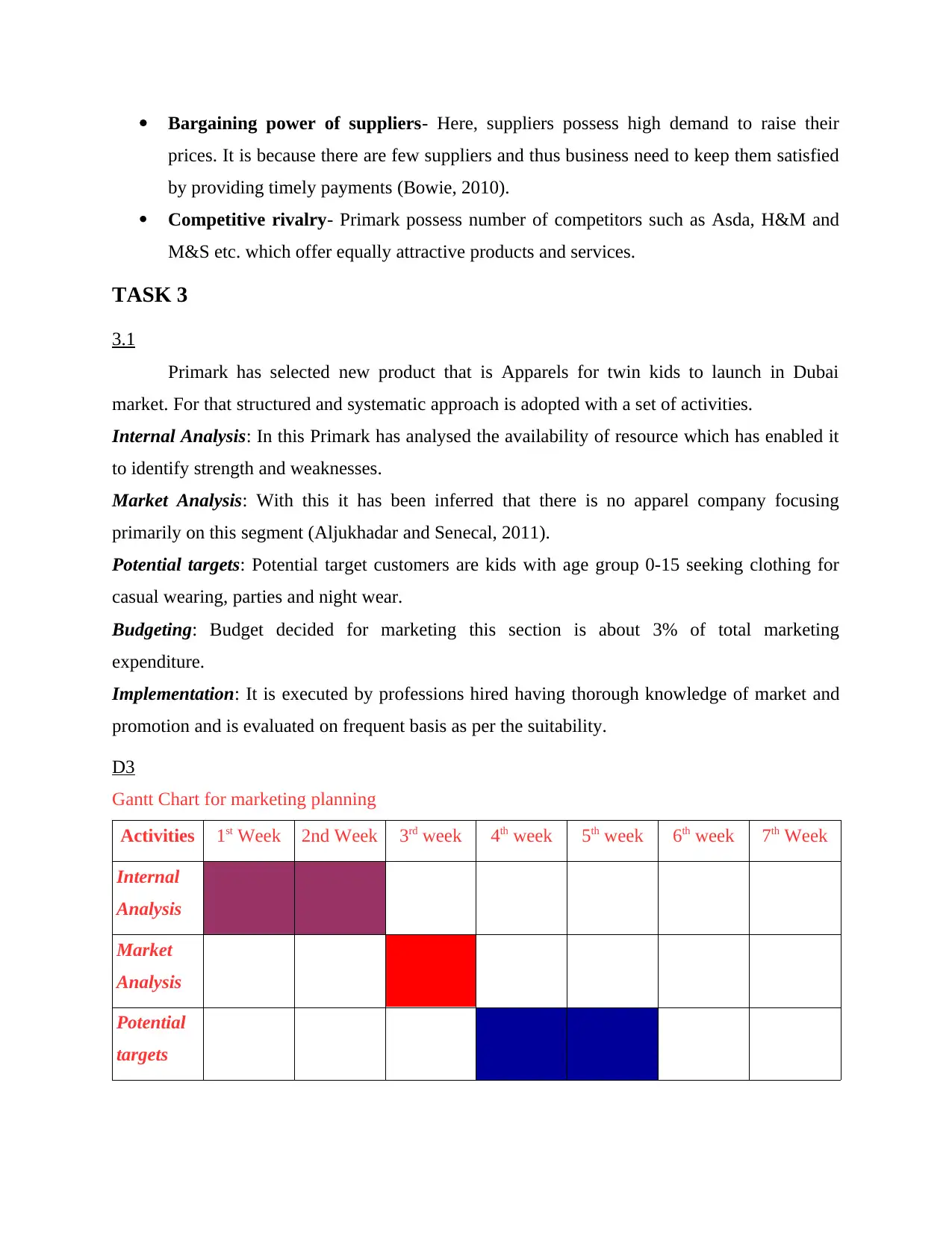
Bargaining power of suppliers- Here, suppliers possess high demand to raise their
prices. It is because there are few suppliers and thus business need to keep them satisfied
by providing timely payments (Bowie, 2010).
Competitive rivalry- Primark possess number of competitors such as Asda, H&M and
M&S etc. which offer equally attractive products and services.
TASK 3
3.1
Primark has selected new product that is Apparels for twin kids to launch in Dubai
market. For that structured and systematic approach is adopted with a set of activities.
Internal Analysis: In this Primark has analysed the availability of resource which has enabled it
to identify strength and weaknesses.
Market Analysis: With this it has been inferred that there is no apparel company focusing
primarily on this segment (Aljukhadar and Senecal, 2011).
Potential targets: Potential target customers are kids with age group 0-15 seeking clothing for
casual wearing, parties and night wear.
Budgeting: Budget decided for marketing this section is about 3% of total marketing
expenditure.
Implementation: It is executed by professions hired having thorough knowledge of market and
promotion and is evaluated on frequent basis as per the suitability.
D3
Gantt Chart for marketing planning
Activities 1st Week 2nd Week 3rd week 4th week 5th week 6th week 7th Week
Internal
Analysis
Market
Analysis
Potential
targets
prices. It is because there are few suppliers and thus business need to keep them satisfied
by providing timely payments (Bowie, 2010).
Competitive rivalry- Primark possess number of competitors such as Asda, H&M and
M&S etc. which offer equally attractive products and services.
TASK 3
3.1
Primark has selected new product that is Apparels for twin kids to launch in Dubai
market. For that structured and systematic approach is adopted with a set of activities.
Internal Analysis: In this Primark has analysed the availability of resource which has enabled it
to identify strength and weaknesses.
Market Analysis: With this it has been inferred that there is no apparel company focusing
primarily on this segment (Aljukhadar and Senecal, 2011).
Potential targets: Potential target customers are kids with age group 0-15 seeking clothing for
casual wearing, parties and night wear.
Budgeting: Budget decided for marketing this section is about 3% of total marketing
expenditure.
Implementation: It is executed by professions hired having thorough knowledge of market and
promotion and is evaluated on frequent basis as per the suitability.
D3
Gantt Chart for marketing planning
Activities 1st Week 2nd Week 3rd week 4th week 5th week 6th week 7th Week
Internal
Analysis
Market
Analysis
Potential
targets
⊘ This is a preview!⊘
Do you want full access?
Subscribe today to unlock all pages.

Trusted by 1+ million students worldwide

Budgeting
Implemen
tation
3.2 & M3
Executive summary
Marketing planning is essential to fulfil the corporate objectives in different ways.
Systematic approach: it enables the business to proceed in structured way with proper direction.
Utilization of resources: With marketing planning company is able to utilize its resources
effectively making operations of Primark cost effective and profitable.
Customer choice: Market analysis makes the Primark to come up with products of customers
choice and preferences
Competitive advantage: Wit identification of strengths and weaknesses of Primark makes it
competitively strong in comparison to offerings given by its rivals (Baker and Hart, 2008).
Effective promotion: With proper marketing planning, Primark is able to promote its new
product more effectively and reach large number of customers.
3.3
Primark is introducing twin clothing product in Dubai market for which it uses given
effective strategy.
Illustration 1: Product Development
Implemen
tation
3.2 & M3
Executive summary
Marketing planning is essential to fulfil the corporate objectives in different ways.
Systematic approach: it enables the business to proceed in structured way with proper direction.
Utilization of resources: With marketing planning company is able to utilize its resources
effectively making operations of Primark cost effective and profitable.
Customer choice: Market analysis makes the Primark to come up with products of customers
choice and preferences
Competitive advantage: Wit identification of strengths and weaknesses of Primark makes it
competitively strong in comparison to offerings given by its rivals (Baker and Hart, 2008).
Effective promotion: With proper marketing planning, Primark is able to promote its new
product more effectively and reach large number of customers.
3.3
Primark is introducing twin clothing product in Dubai market for which it uses given
effective strategy.
Illustration 1: Product Development
Paraphrase This Document
Need a fresh take? Get an instant paraphrase of this document with our AI Paraphraser

According to given illustration there are four factors for product development :creation,
innovation, improvement and enhancement (Bunnell, 2005). Although, Primark make use of two
elements only that are specified below: Creation: This parameter signifies that an entirely new product is framed by production
team. Here, additional feature are added to existing raw material so that new product is
developed. Primark use this factor to improve its brand equity.
Innovation: It refers to up gradation of existing production techniques so that it a new
product is framed (Jahdi and Acikdilli, 2009). Primark focuses on adopting new
technology for desgining twin clothes for Dubai market. These two techniques are
beneficial for concerned company to increase its respective product sale.
3.4
In order to achieve desired outcome Primark should make effective use of pricing,
distribution and communication policy, which is briefly discussed below: Premium pricing policy: Primark will set price of concerned product comparative;ly high
in the market. The company will be benefited in dual manner : firstly, brand image will
be created in market and secondly it will maximize profit of the company with each
purchase. Integrated distribution channel: Company will make effective use of distribution channel
to avail product to target market. Integrated distribution channel will make use of
different retail outlets, wholesalers, stores and online shopping mode to broader the area
of sale and purchase (Kotler, 2011).
Two way communication channel: Clearly defined instructions will be communicated
between company and customers. Two way communication policy will lead to active
participation of clients in decision making of Primark.
3.5
Effective implementation of plan is reviewed by considering the following factors.
Earnings generated: The effectiveness of the plan is judged by the overall increment in sales
occurred to the organisation Primark and the earnings generated through them. With the proper
marketing customer base get widen.
Customer satisfaction: It leads to the increased in satisfaction level of customers.
innovation, improvement and enhancement (Bunnell, 2005). Although, Primark make use of two
elements only that are specified below: Creation: This parameter signifies that an entirely new product is framed by production
team. Here, additional feature are added to existing raw material so that new product is
developed. Primark use this factor to improve its brand equity.
Innovation: It refers to up gradation of existing production techniques so that it a new
product is framed (Jahdi and Acikdilli, 2009). Primark focuses on adopting new
technology for desgining twin clothes for Dubai market. These two techniques are
beneficial for concerned company to increase its respective product sale.
3.4
In order to achieve desired outcome Primark should make effective use of pricing,
distribution and communication policy, which is briefly discussed below: Premium pricing policy: Primark will set price of concerned product comparative;ly high
in the market. The company will be benefited in dual manner : firstly, brand image will
be created in market and secondly it will maximize profit of the company with each
purchase. Integrated distribution channel: Company will make effective use of distribution channel
to avail product to target market. Integrated distribution channel will make use of
different retail outlets, wholesalers, stores and online shopping mode to broader the area
of sale and purchase (Kotler, 2011).
Two way communication channel: Clearly defined instructions will be communicated
between company and customers. Two way communication policy will lead to active
participation of clients in decision making of Primark.
3.5
Effective implementation of plan is reviewed by considering the following factors.
Earnings generated: The effectiveness of the plan is judged by the overall increment in sales
occurred to the organisation Primark and the earnings generated through them. With the proper
marketing customer base get widen.
Customer satisfaction: It leads to the increased in satisfaction level of customers.
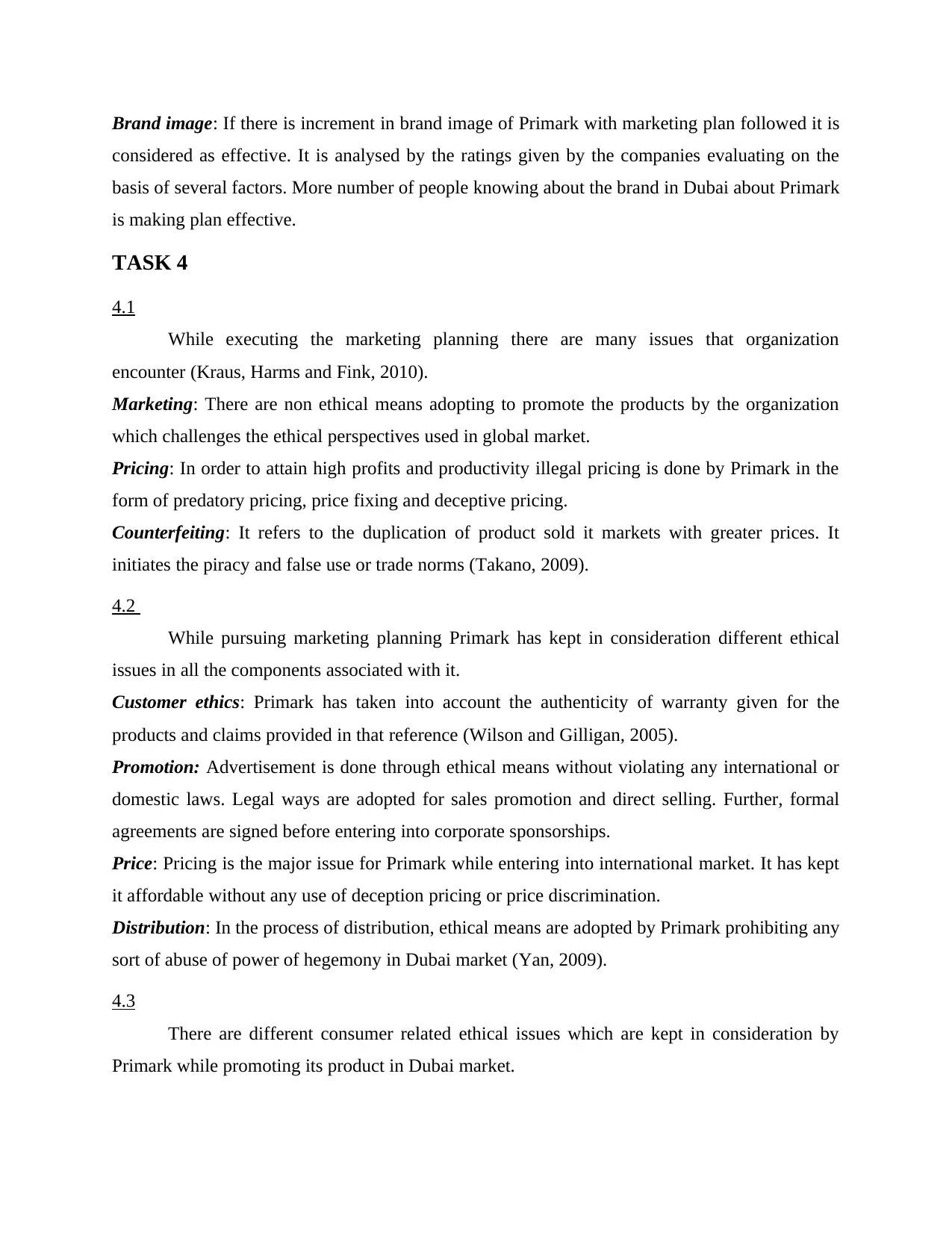
Brand image: If there is increment in brand image of Primark with marketing plan followed it is
considered as effective. It is analysed by the ratings given by the companies evaluating on the
basis of several factors. More number of people knowing about the brand in Dubai about Primark
is making plan effective.
TASK 4
4.1
While executing the marketing planning there are many issues that organization
encounter (Kraus, Harms and Fink, 2010).
Marketing: There are non ethical means adopting to promote the products by the organization
which challenges the ethical perspectives used in global market.
Pricing: In order to attain high profits and productivity illegal pricing is done by Primark in the
form of predatory pricing, price fixing and deceptive pricing.
Counterfeiting: It refers to the duplication of product sold it markets with greater prices. It
initiates the piracy and false use or trade norms (Takano, 2009).
4.2
While pursuing marketing planning Primark has kept in consideration different ethical
issues in all the components associated with it.
Customer ethics: Primark has taken into account the authenticity of warranty given for the
products and claims provided in that reference (Wilson and Gilligan, 2005).
Promotion: Advertisement is done through ethical means without violating any international or
domestic laws. Legal ways are adopted for sales promotion and direct selling. Further, formal
agreements are signed before entering into corporate sponsorships.
Price: Pricing is the major issue for Primark while entering into international market. It has kept
it affordable without any use of deception pricing or price discrimination.
Distribution: In the process of distribution, ethical means are adopted by Primark prohibiting any
sort of abuse of power of hegemony in Dubai market (Yan, 2009).
4.3
There are different consumer related ethical issues which are kept in consideration by
Primark while promoting its product in Dubai market.
considered as effective. It is analysed by the ratings given by the companies evaluating on the
basis of several factors. More number of people knowing about the brand in Dubai about Primark
is making plan effective.
TASK 4
4.1
While executing the marketing planning there are many issues that organization
encounter (Kraus, Harms and Fink, 2010).
Marketing: There are non ethical means adopting to promote the products by the organization
which challenges the ethical perspectives used in global market.
Pricing: In order to attain high profits and productivity illegal pricing is done by Primark in the
form of predatory pricing, price fixing and deceptive pricing.
Counterfeiting: It refers to the duplication of product sold it markets with greater prices. It
initiates the piracy and false use or trade norms (Takano, 2009).
4.2
While pursuing marketing planning Primark has kept in consideration different ethical
issues in all the components associated with it.
Customer ethics: Primark has taken into account the authenticity of warranty given for the
products and claims provided in that reference (Wilson and Gilligan, 2005).
Promotion: Advertisement is done through ethical means without violating any international or
domestic laws. Legal ways are adopted for sales promotion and direct selling. Further, formal
agreements are signed before entering into corporate sponsorships.
Price: Pricing is the major issue for Primark while entering into international market. It has kept
it affordable without any use of deception pricing or price discrimination.
Distribution: In the process of distribution, ethical means are adopted by Primark prohibiting any
sort of abuse of power of hegemony in Dubai market (Yan, 2009).
4.3
There are different consumer related ethical issues which are kept in consideration by
Primark while promoting its product in Dubai market.
⊘ This is a preview!⊘
Do you want full access?
Subscribe today to unlock all pages.

Trusted by 1+ million students worldwide
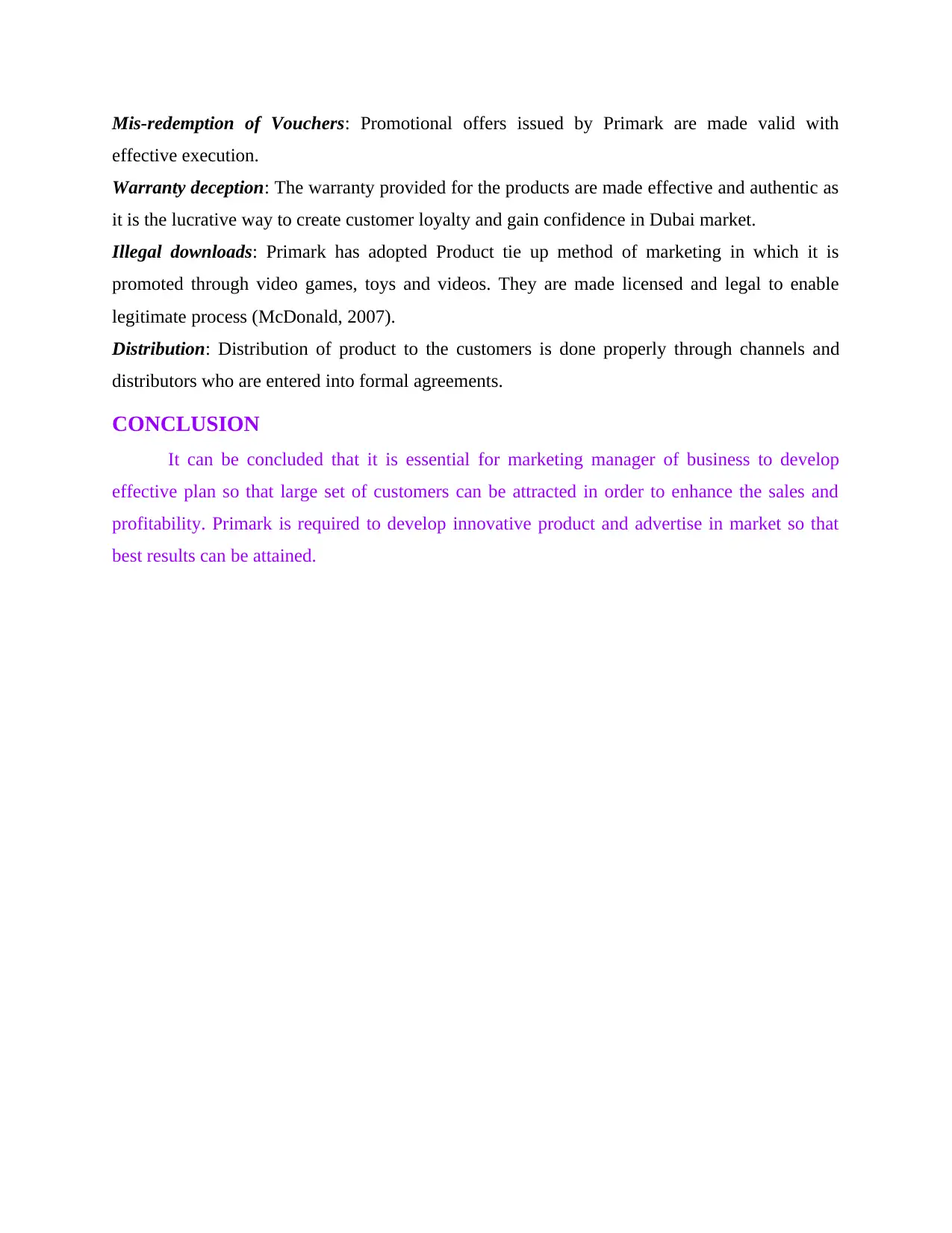
Mis-redemption of Vouchers: Promotional offers issued by Primark are made valid with
effective execution.
Warranty deception: The warranty provided for the products are made effective and authentic as
it is the lucrative way to create customer loyalty and gain confidence in Dubai market.
Illegal downloads: Primark has adopted Product tie up method of marketing in which it is
promoted through video games, toys and videos. They are made licensed and legal to enable
legitimate process (McDonald, 2007).
Distribution: Distribution of product to the customers is done properly through channels and
distributors who are entered into formal agreements.
CONCLUSION
It can be concluded that it is essential for marketing manager of business to develop
effective plan so that large set of customers can be attracted in order to enhance the sales and
profitability. Primark is required to develop innovative product and advertise in market so that
best results can be attained.
effective execution.
Warranty deception: The warranty provided for the products are made effective and authentic as
it is the lucrative way to create customer loyalty and gain confidence in Dubai market.
Illegal downloads: Primark has adopted Product tie up method of marketing in which it is
promoted through video games, toys and videos. They are made licensed and legal to enable
legitimate process (McDonald, 2007).
Distribution: Distribution of product to the customers is done properly through channels and
distributors who are entered into formal agreements.
CONCLUSION
It can be concluded that it is essential for marketing manager of business to develop
effective plan so that large set of customers can be attracted in order to enhance the sales and
profitability. Primark is required to develop innovative product and advertise in market so that
best results can be attained.
Paraphrase This Document
Need a fresh take? Get an instant paraphrase of this document with our AI Paraphraser
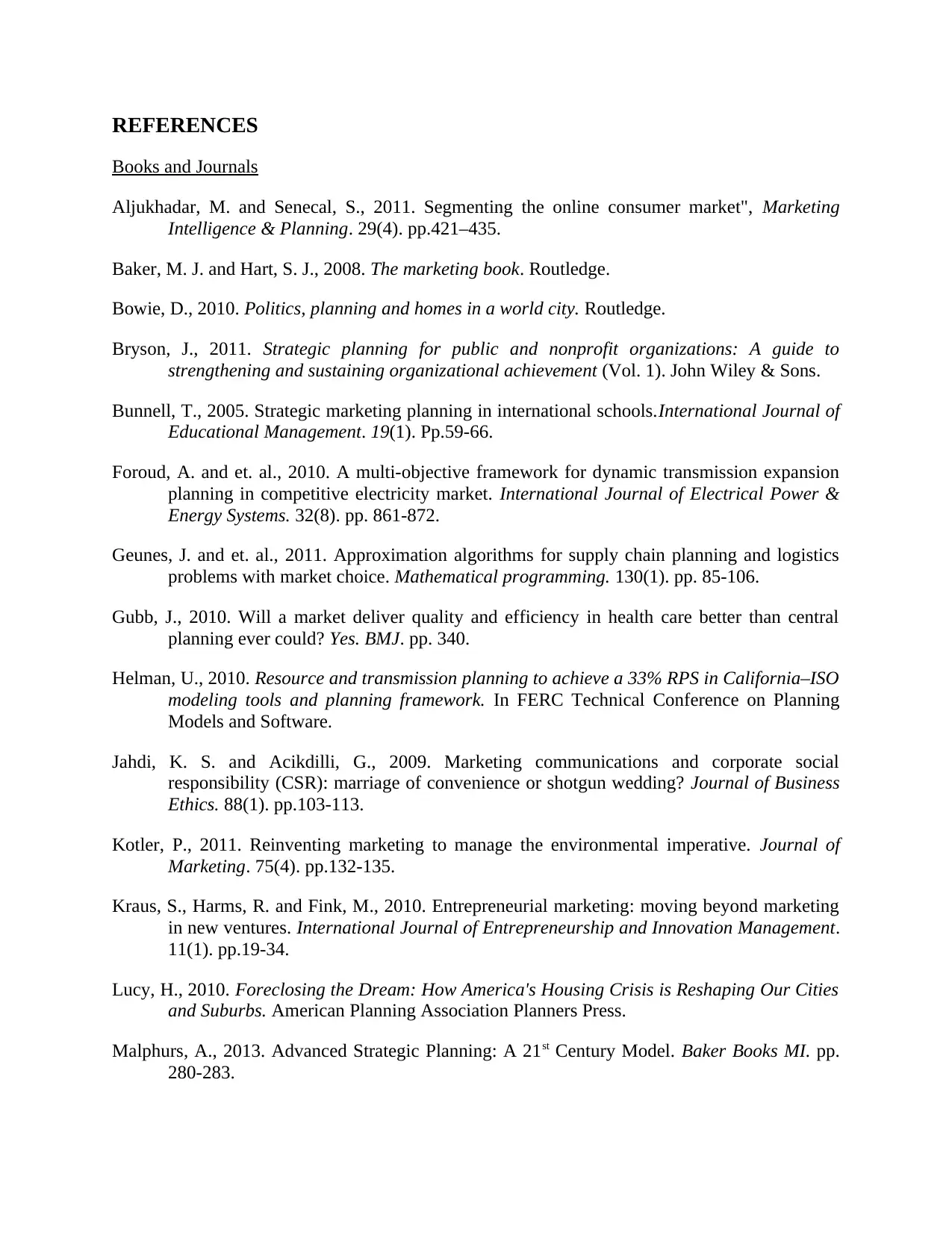
REFERENCES
Books and Journals
Aljukhadar, M. and Senecal, S., 2011. Segmenting the online consumer market", Marketing
Intelligence & Planning. 29(4). pp.421–435.
Baker, M. J. and Hart, S. J., 2008. The marketing book. Routledge.
Bowie, D., 2010. Politics, planning and homes in a world city. Routledge.
Bryson, J., 2011. Strategic planning for public and nonprofit organizations: A guide to
strengthening and sustaining organizational achievement (Vol. 1). John Wiley & Sons.
Bunnell, T., 2005. Strategic marketing planning in international schools.International Journal of
Educational Management. 19(1). Pp.59-66.
Foroud, A. and et. al., 2010. A multi-objective framework for dynamic transmission expansion
planning in competitive electricity market. International Journal of Electrical Power &
Energy Systems. 32(8). pp. 861-872.
Geunes, J. and et. al., 2011. Approximation algorithms for supply chain planning and logistics
problems with market choice. Mathematical programming. 130(1). pp. 85-106.
Gubb, J., 2010. Will a market deliver quality and efficiency in health care better than central
planning ever could? Yes. BMJ. pp. 340.
Helman, U., 2010. Resource and transmission planning to achieve a 33% RPS in California–ISO
modeling tools and planning framework. In FERC Technical Conference on Planning
Models and Software.
Jahdi, K. S. and Acikdilli, G., 2009. Marketing communications and corporate social
responsibility (CSR): marriage of convenience or shotgun wedding? Journal of Business
Ethics. 88(1). pp.103-113.
Kotler, P., 2011. Reinventing marketing to manage the environmental imperative. Journal of
Marketing. 75(4). pp.132-135.
Kraus, S., Harms, R. and Fink, M., 2010. Entrepreneurial marketing: moving beyond marketing
in new ventures. International Journal of Entrepreneurship and Innovation Management.
11(1). pp.19-34.
Lucy, H., 2010. Foreclosing the Dream: How America's Housing Crisis is Reshaping Our Cities
and Suburbs. American Planning Association Planners Press.
Malphurs, A., 2013. Advanced Strategic Planning: A 21st Century Model. Baker Books MI. pp.
280-283.
Books and Journals
Aljukhadar, M. and Senecal, S., 2011. Segmenting the online consumer market", Marketing
Intelligence & Planning. 29(4). pp.421–435.
Baker, M. J. and Hart, S. J., 2008. The marketing book. Routledge.
Bowie, D., 2010. Politics, planning and homes in a world city. Routledge.
Bryson, J., 2011. Strategic planning for public and nonprofit organizations: A guide to
strengthening and sustaining organizational achievement (Vol. 1). John Wiley & Sons.
Bunnell, T., 2005. Strategic marketing planning in international schools.International Journal of
Educational Management. 19(1). Pp.59-66.
Foroud, A. and et. al., 2010. A multi-objective framework for dynamic transmission expansion
planning in competitive electricity market. International Journal of Electrical Power &
Energy Systems. 32(8). pp. 861-872.
Geunes, J. and et. al., 2011. Approximation algorithms for supply chain planning and logistics
problems with market choice. Mathematical programming. 130(1). pp. 85-106.
Gubb, J., 2010. Will a market deliver quality and efficiency in health care better than central
planning ever could? Yes. BMJ. pp. 340.
Helman, U., 2010. Resource and transmission planning to achieve a 33% RPS in California–ISO
modeling tools and planning framework. In FERC Technical Conference on Planning
Models and Software.
Jahdi, K. S. and Acikdilli, G., 2009. Marketing communications and corporate social
responsibility (CSR): marriage of convenience or shotgun wedding? Journal of Business
Ethics. 88(1). pp.103-113.
Kotler, P., 2011. Reinventing marketing to manage the environmental imperative. Journal of
Marketing. 75(4). pp.132-135.
Kraus, S., Harms, R. and Fink, M., 2010. Entrepreneurial marketing: moving beyond marketing
in new ventures. International Journal of Entrepreneurship and Innovation Management.
11(1). pp.19-34.
Lucy, H., 2010. Foreclosing the Dream: How America's Housing Crisis is Reshaping Our Cities
and Suburbs. American Planning Association Planners Press.
Malphurs, A., 2013. Advanced Strategic Planning: A 21st Century Model. Baker Books MI. pp.
280-283.
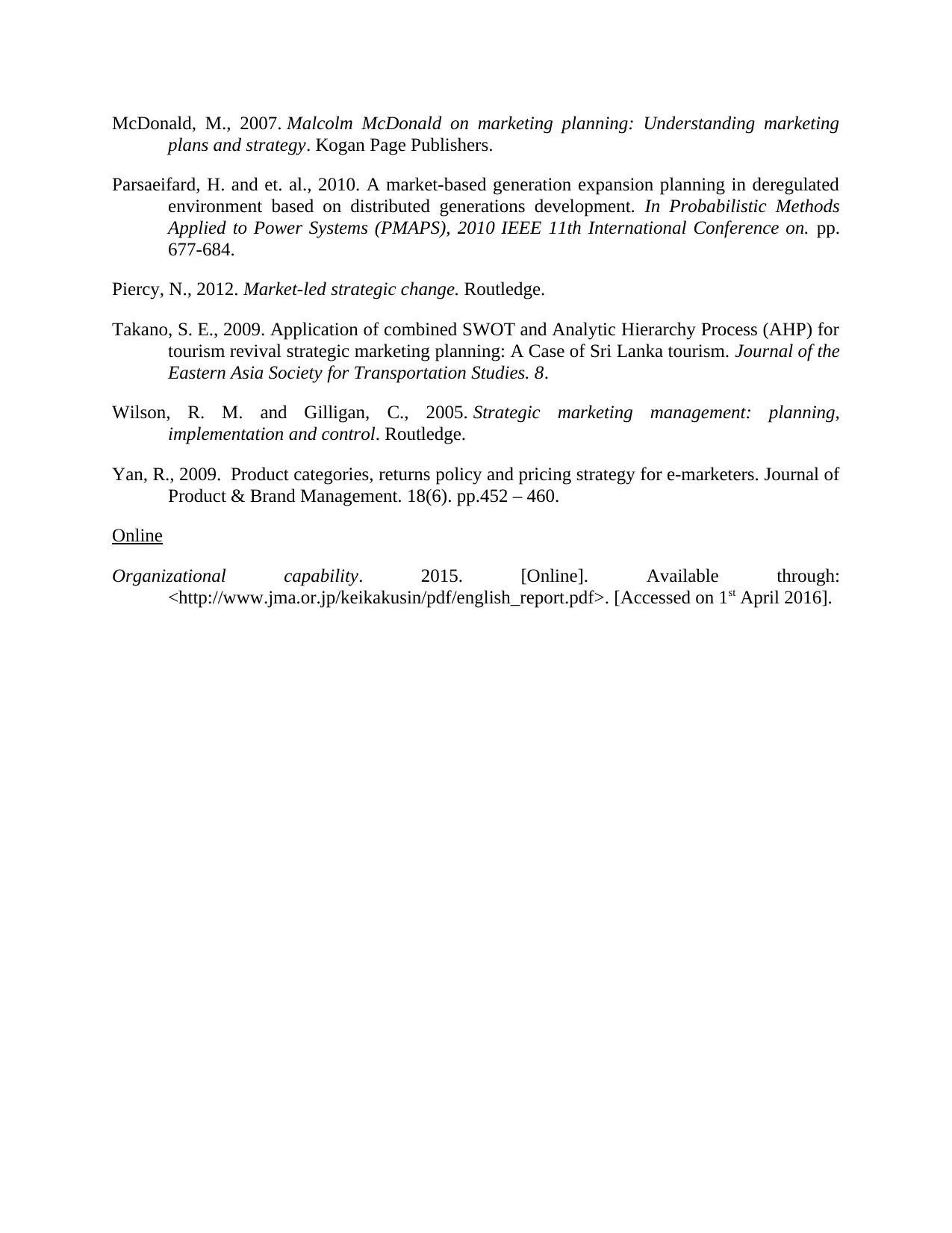
McDonald, M., 2007. Malcolm McDonald on marketing planning: Understanding marketing
plans and strategy. Kogan Page Publishers.
Parsaeifard, H. and et. al., 2010. A market-based generation expansion planning in deregulated
environment based on distributed generations development. In Probabilistic Methods
Applied to Power Systems (PMAPS), 2010 IEEE 11th International Conference on. pp.
677-684.
Piercy, N., 2012. Market-led strategic change. Routledge.
Takano, S. E., 2009. Application of combined SWOT and Analytic Hierarchy Process (AHP) for
tourism revival strategic marketing planning: A Case of Sri Lanka tourism. Journal of the
Eastern Asia Society for Transportation Studies. 8.
Wilson, R. M. and Gilligan, C., 2005. Strategic marketing management: planning,
implementation and control. Routledge.
Yan, R., 2009. Product categories, returns policy and pricing strategy for e‐marketers. Journal of
Product & Brand Management. 18(6). pp.452 – 460.
Online
Organizational capability. 2015. [Online]. Available through:
<http://www.jma.or.jp/keikakusin/pdf/english_report.pdf>. [Accessed on 1st April 2016].
plans and strategy. Kogan Page Publishers.
Parsaeifard, H. and et. al., 2010. A market-based generation expansion planning in deregulated
environment based on distributed generations development. In Probabilistic Methods
Applied to Power Systems (PMAPS), 2010 IEEE 11th International Conference on. pp.
677-684.
Piercy, N., 2012. Market-led strategic change. Routledge.
Takano, S. E., 2009. Application of combined SWOT and Analytic Hierarchy Process (AHP) for
tourism revival strategic marketing planning: A Case of Sri Lanka tourism. Journal of the
Eastern Asia Society for Transportation Studies. 8.
Wilson, R. M. and Gilligan, C., 2005. Strategic marketing management: planning,
implementation and control. Routledge.
Yan, R., 2009. Product categories, returns policy and pricing strategy for e‐marketers. Journal of
Product & Brand Management. 18(6). pp.452 – 460.
Online
Organizational capability. 2015. [Online]. Available through:
<http://www.jma.or.jp/keikakusin/pdf/english_report.pdf>. [Accessed on 1st April 2016].
⊘ This is a preview!⊘
Do you want full access?
Subscribe today to unlock all pages.

Trusted by 1+ million students worldwide
1 out of 12
Related Documents
Your All-in-One AI-Powered Toolkit for Academic Success.
+13062052269
info@desklib.com
Available 24*7 on WhatsApp / Email
![[object Object]](/_next/static/media/star-bottom.7253800d.svg)
Unlock your academic potential
Copyright © 2020–2025 A2Z Services. All Rights Reserved. Developed and managed by ZUCOL.





